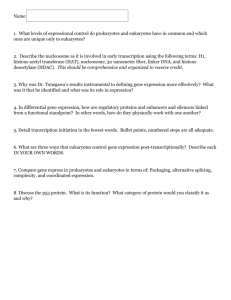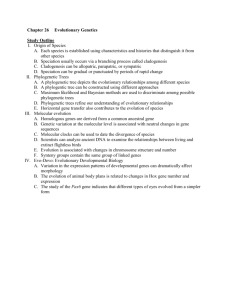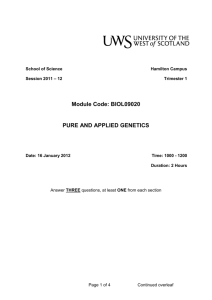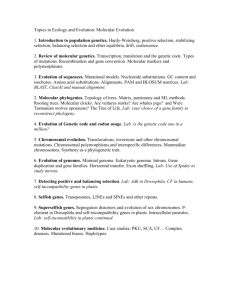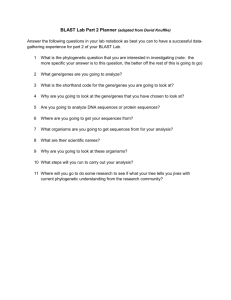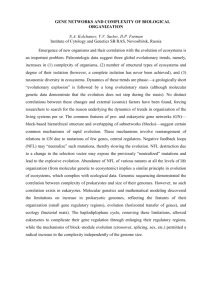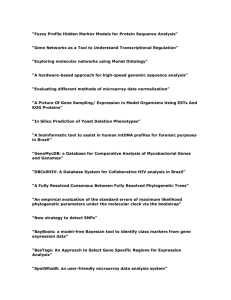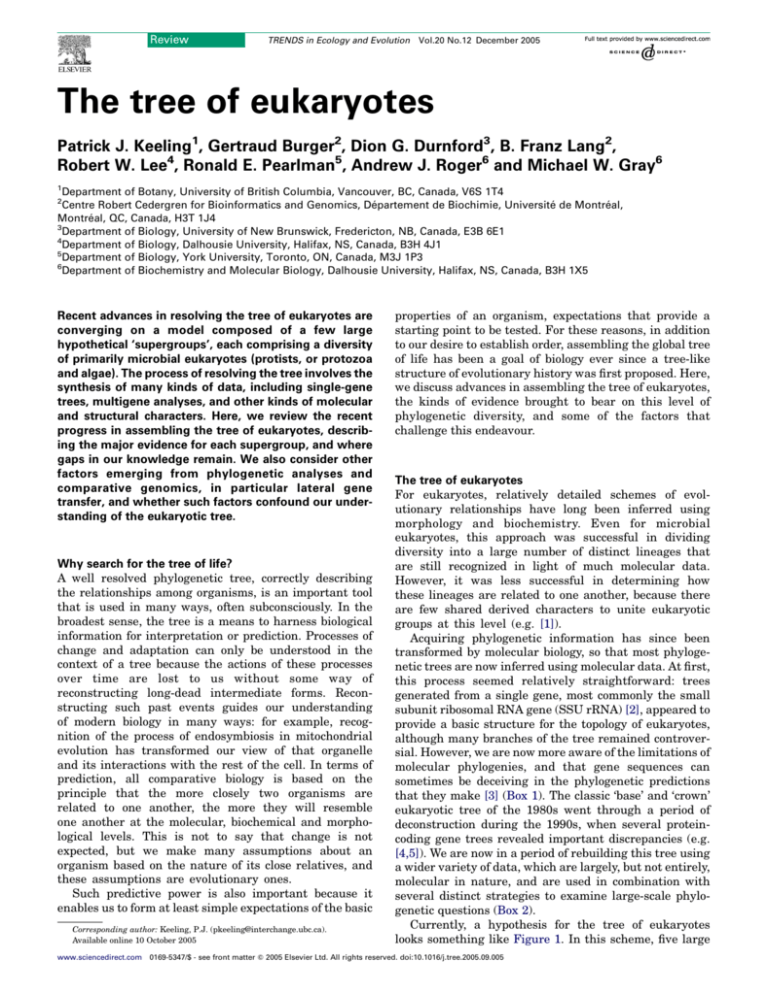
Review
TRENDS in Ecology and Evolution
Vol.20 No.12 December 2005
The tree of eukaryotes
Patrick J. Keeling1, Gertraud Burger2, Dion G. Durnford3, B. Franz Lang2,
Robert W. Lee4, Ronald E. Pearlman5, Andrew J. Roger6 and Michael W. Gray6
1
Department of Botany, University of British Columbia, Vancouver, BC, Canada, V6S 1T4
Centre Robert Cedergren for Bioinformatics and Genomics, Département de Biochimie, Université de Montréal,
Montréal, QC, Canada, H3T 1J4
3
Department of Biology, University of New Brunswick, Fredericton, NB, Canada, E3B 6E1
4
Department of Biology, Dalhousie University, Halifax, NS, Canada, B3H 4J1
5
Department of Biology, York University, Toronto, ON, Canada, M3J 1P3
6
Department of Biochemistry and Molecular Biology, Dalhousie University, Halifax, NS, Canada, B3H 1X5
2
Recent advances in resolving the tree of eukaryotes are
converging on a model composed of a few large
hypothetical ‘supergroups’, each comprising a diversity
of primarily microbial eukaryotes (protists, or protozoa
and algae). The process of resolving the tree involves the
synthesis of many kinds of data, including single-gene
trees, multigene analyses, and other kinds of molecular
and structural characters. Here, we review the recent
progress in assembling the tree of eukaryotes, describing the major evidence for each supergroup, and where
gaps in our knowledge remain. We also consider other
factors emerging from phylogenetic analyses and
comparative genomics, in particular lateral gene
transfer, and whether such factors confound our understanding of the eukaryotic tree.
Why search for the tree of life?
A well resolved phylogenetic tree, correctly describing
the relationships among organisms, is an important tool
that is used in many ways, often subconsciously. In the
broadest sense, the tree is a means to harness biological
information for interpretation or prediction. Processes of
change and adaptation can only be understood in the
context of a tree because the actions of these processes
over time are lost to us without some way of
reconstructing long-dead intermediate forms. Reconstructing such past events guides our understanding
of modern biology in many ways: for example, recognition of the process of endosymbiosis in mitochondrial
evolution has transformed our view of that organelle
and its interactions with the rest of the cell. In terms of
prediction, all comparative biology is based on the
principle that the more closely two organisms are
related to one another, the more they will resemble
one another at the molecular, biochemical and morphological levels. This is not to say that change is not
expected, but we make many assumptions about an
organism based on the nature of its close relatives, and
these assumptions are evolutionary ones.
Such predictive power is also important because it
enables us to form at least simple expectations of the basic
Corresponding author: Keeling, P.J. (pkeeling@interchange.ubc.ca).
Available online 10 October 2005
properties of an organism, expectations that provide a
starting point to be tested. For these reasons, in addition
to our desire to establish order, assembling the global tree
of life has been a goal of biology ever since a tree-like
structure of evolutionary history was first proposed. Here,
we discuss advances in assembling the tree of eukaryotes,
the kinds of evidence brought to bear on this level of
phylogenetic diversity, and some of the factors that
challenge this endeavour.
The tree of eukaryotes
For eukaryotes, relatively detailed schemes of evolutionary relationships have long been inferred using
morphology and biochemistry. Even for microbial
eukaryotes, this approach was successful in dividing
diversity into a large number of distinct lineages that
are still recognized in light of much molecular data.
However, it was less successful in determining how
these lineages are related to one another, because there
are few shared derived characters to unite eukaryotic
groups at this level (e.g. [1]).
Acquiring phylogenetic information has since been
transformed by molecular biology, so that most phylogenetic trees are now inferred using molecular data. At first,
this process seemed relatively straightforward: trees
generated from a single gene, most commonly the small
subunit ribosomal RNA gene (SSU rRNA) [2], appeared to
provide a basic structure for the topology of eukaryotes,
although many branches of the tree remained controversial. However, we are now more aware of the limitations of
molecular phylogenies, and that gene sequences can
sometimes be deceiving in the phylogenetic predictions
that they make [3] (Box 1). The classic ‘base’ and ‘crown’
eukaryotic tree of the 1980s went through a period of
deconstruction during the 1990s, when several proteincoding gene trees revealed important discrepancies (e.g.
[4,5]). We are now in a period of rebuilding this tree using
a wider variety of data, which are largely, but not entirely,
molecular in nature, and are used in combination with
several distinct strategies to examine large-scale phylogenetic questions (Box 2).
Currently, a hypothesis for the tree of eukaryotes
looks something like Figure 1. In this scheme, five large
www.sciencedirect.com 0169-5347/$ - see front matter Q 2005 Elsevier Ltd. All rights reserved. doi:10.1016/j.tree.2005.09.005
Review
TRENDS in Ecology and Evolution
Vol.20 No.12 December 2005
671
Box 1. Assembling the tree of eukaryotes
Every individual phylogeny is probably correct in some respects but
misleading in others. Single-gene trees cannot be taken at face value
for ancient relationships, so several methods have been used to
‘assemble’ the tree of eukaryotes from diverse data.
Individual gene trees
Although they must be interpreted cautiously, single-gene trees
continue to be valuable because, whereas one gene tree might fail
to infer the relationship between, for example, animals and fungi, five
other trees might resolve this affiliation robustly. By judiciously
interpreting several individual trees (and incorporating other sorts of
information), relationships emerge by congruence. The problem is
that interpretations are open to differences of opinion among
researchers, with no objective means to discriminate among these
differing viewpoints.
Combining data
The most common approach in combining data for phylogenetic
analysis is to concatenate sequences, resulting in a large amount of
data from which a single tree is inferred. Early multi-gene studies
treated such a concatenated data set as if it were one large ‘supergene’, estimating phylogenies by standard methods [26]. However,
this ignores the fact that the various genes being combined might
have somewhat different properties, such as variant rates-across-sites
distributions, different substitution models and, most importantly,
distinct rates of evolution. Ignoring such gene-specific effects risks
introducing systematic error in the phylogenetic estimation. Newer
approaches incorporate estimation of gene-specific parameter sets
during phylogenetic analysis [66,67].
A different approach is to combine estimated trees themselves into a
larger ‘supertrees’. Recently developed methods for supertree
‘supergroups’ describe eukaryotic diversity, but the
order of divergence among these groups is uncertain.
Most of these organisms are microbial [protists (protozoa and algae)]. Remarkably, the core elements of
three of these five groups have only been proposed
during the past few years (and, accordingly, remain
controversial), attesting to the scale of the changes that
are reshaping our view of eukaryotic diversity.
analysis are becoming increasingly popular, and are useful when the
taxonomic representation of different gene sets is heterogeneous [68].
However, caution is warranted because sophisticated statistical
techniques have yet to be developed for propagating the uncertainty
in the original phylogenies into the final supertrees.
Assembling such data sets is a challenge and, even with wholegenome sequences, many taxa lack certain genes, so that concatenated gene sets generally feature ‘missing data’ [46]. Nevertheless,
these approaches have been successful in several instances, most
often at first using organelle (mitochondrial and chloroplast) gene
data but more recently using nucleus-encoded sequences [27,28,66].
These successes notwithstanding, the nature of concatenated data is
only partly understood, and some characteristics are potentially
problematic because large data sets are thought to reduce stochastic
error but to emphasize systematic errors (Box 2). In this respect, we
would do well to remember that our over-confidence in early
molecular phylogenies based on simplistic evolutionary models led
to acceptance of several misleading conclusions, correction of which
took many years.
Discrete molecular characters
Phylogenetic information that is not necessarily dependent on
phylogenetic reconstruction (and associated problems) might be
found within conserved insertions or deletions in gene sequences
[23], intron positions, gene fusions or splits [7], or other complex
molecular events. If these characters are highly conserved and shared
by two or more organisms to the exclusion of others, they might well
be informative, although each such character exhibits its own sources
of error (e.g. convergence, recombination and/or parallel loss) and
must be interpreted with as much caution as is a molecular phylogeny.
Although a certain degree of controversy remains for
each supergroup, all five currently represent reasonable
hypotheses based on available data. Nevertheless,
additional supporting evidence is required for all five
assemblages before they become universally accepted.
Below, we review each supergroup and some of the
evidence supporting them (the root of this tree is
discussed elsewhere [6–8]; Box 3).
Box 2. How far back in time is molecular phylogeny able to reach?
The difficulties in inferring reliable molecular phylogenies over
hundreds of millions to billions of years stem from two major sources:
(i) random error; and (ii) systematic error.
compared sequences) the more likely it is that it will retain ancient
historical signal.
Systematic error
Random error
Random error (or random noise) arises when the data contain too little
information, resulting in a poorly resolved phylogeny. This problem is
particularly acute over long timescales, because sites in molecules
become saturated with multiple changes, erasing the deep phylogenetic signal. Some authors have recently shown that, if molecules
evolve according to simple rules such as those of a Jukes-Cantor
process (where all nucleotides or amino acids occur at equal
frequencies and are interchanged with equal rates), historical
information is lost rather rapidly and abruptly [69]. However, if
molecules evolve in a more complex fashion (i.e. with variation in
rates of evolution across sites and/or variation in rates at the same site
over the tree), then phylogenetic information might persist over much
longer timescales [69,70]. These more complex models do appear to
describe real data significantly better than do simpler models [71].
Therefore, provided sufficient data are considered, it should be
possible to infer ancient relationships. Of crucial importance,
however, is the average rate of evolution of a given gene. For
organismal divergences on a billion-year timescale, the more slowly a
protein evolves (provided there is still some variation among the
www.sciencedirect.com
Systematic error describes the failure of a phylogenetic method to
recover the correct tree, instead selecting a particular alternative
topology as optimal, often with strong apparent statistical support.
This typically occurs when the phylogenetic model used is overly
simplistic, and it is particularly problematic for deep divergences,
because most of the assumptions of even the most complex available
phylogenetic models are violated by the true molecular evolutionary
process over billions of years. Failure to model correctly rates-acrosssites distributions, changing rates at sites over the tree, changing
nucleotide and/or amino acid and/or codon usage among species and
site-specific substitution properties all can lead to systematic error in
tree estimation. The most common manifestation of this error is the
erroneous grouping together of the most ‘divergent’ sequences, a
phenomenon known as ‘long branch attraction’. The development of
more realistic models of molecular evolution is a rapidly expanding
field of theoretical phylogenetics [72].
Ultimately, the most promising approach to maximize the chances of
recovering an accurate and robust tree of eukaryotes (Box 1) is to utilize
information from as many slowly evolving proteins as possible in
phylogenetic analyses using sufficiently accurate substitution models.
Review
672
Plantae
TRENDS in Ecology and Evolution
Streptophytes
Green
Red Algae
Land plants
Charophytes
Algae
Chlorophytes
Trebouxiophytes
Ulvophytes
Prasinophytes
Mesostigma
Floridiophytes
Bangiophytes
Cyanidiophytes
Glaucophytes
Alveolates
Vol.20 No.12 December 2005
Excavates
Discicristates
Heterolobosea
Kinetoplastids
Diplonemids
Euglenids
Core jakobids
Trimastix
Oxymonads
Trichomonads
Hypermastigotes
Carpediemonas
Retortamonads
Diplomonads
Malawimonads
Cercomonads
Euglyphids
Cercozoa
Phaeodarea
Heteromitids
Thaumatomonads
Chlorarachniophytes
Phytomyxids
Haplosporidia
Foraminifera
Polycystines
Acantharia
Rhizaria
Apicomplexa
Colpodella
Dinoflagellates
Oxyhrris
Perkinsus
Ciliates
Colponema
Ellobiopsids
Diatoms
Raphidiophytes
Eustigmatophytes
Chrysophytes
Phaeophytes
Bolidophytes
Blastocystis
Actinophryids
Labyrinthulids
Stramenopiles
Thraustrochytrids
Oomycetes
Opalinids
Bicosoecids
Haptophytes
Cryptomonads
Chromalveolates
Ascomycetes
Basidiomycetes
Zygomycetes
Microsporidia
Chytrids
Nucleariids
Animals
Choanoflagellates
Opisthokonts
Capsaspora
Ichthyosporea
Dictyostelids
Myxogastrids
Protostelids
Lobosea
Archamoebae
Amoebozoa
‘Unikonts’
TRENDS in Ecology & Evolution
Figure 1. A tree of eukaryotes. The tree is a hypothesis composed from the various types of data discussed in the text, including molecular phylogenies and other molecular
characters, as well as morphological and biochemical evidence. Five ‘supergroups’ are shown, each consisting of a diversity of eukaryotes, most of which are microbial
(mostly protists and algae). Relationships are left unresolved (i.e. where several branches emerge simultaneously) when there is little or no evidence for the branching order.
Other branches are shown dotted when there are only preliminary indications for this relationship. A handful of ‘orphan’ genera and two groups, Apusazoa and centrohelid
Heliozoa, are not shown. There are few data from these organisms and they are not yet associated with any of these groups.
Excavates
The excavates are a diverse group of protists, many of
which are anaerobic and/or parasitic, the best known
being Trypanosoma, Giardia and Trichomonas. Excavates
are loosely united by a combination of molecular and
morphological evidence [9]. To date, no single kind of
evidence supports the entire group, but there are
morphological similarities in cytoskeletal ultrastructure
uniting a subset of excavates, and molecular phylogenetic
data to support relationships for overlapping subsets. The
two kinds of evidence considered together form a web that
unites the entire group [9–11]. Several excavate groups
www.sciencedirect.com
(along with some taxa now known not to be related to
excavates) were long considered to be ancient eukaryotic
lineages that primitively lacked mitochondria [12]. However, with the exception of oxymonads and retortamonads,
evidence for homologues of mitochondrial proteins and
relict organelles has now been found in all of these taxa
[13–16]. Whether these organisms should still be considered early eukaryotic lineages is less clear, but a recent
hypothesis for the root of eukaryotes suggests they that
are not [7]; currently, there is no evidence that directly
supports an early divergence of these taxa from other
eukaryotes [17].
Review
TRENDS in Ecology and Evolution
Vol.20 No.12 December 2005
673
Box 3. How old are eukaryotes?
The earliest fossil record for eukaryotes is notoriously controversial.
Biomarker molecules and macro- and microfossils reminiscent of
eukaryotes occur spottily in the fossil record from 1 billion–2.7 billion
years ago (Bya), but whether these entities are truly the remains of
ancient eukaryotes is debatable. The oldest fossil that is widely
regarded to be of a ‘crown’ group eukaryote is a bangiophyte red alga
from 1.2 Bya [73] and, although more candidates are emerging [74,75],
most other plausible fossils of crown-group eukaryotes occur more
recently than w1 Bya [76].
This patchy fossil record has motivated several recent analyses
aimed at dating the earliest divergences in the tree of eukaryotes using
fossil-calibrated ‘molecular dating’ methods [77,78]. However, different analyses often give wildly differing divergence time estimates and
remain controversial. For instance, using dozens to hundreds of
protein genes and several dating methods, Hedges et al. [77] argued
that the common ancestor of extant eukaryotes existed 2.3 Bya.
Rhizarians
Rhizaria is one of the most recently recognized eukaryotic
supergroups [18,19], and is also distinguished by being
united only by molecular data (i.e. no clearly homologous
morphological character uniquely defines this group).
Rhizarians are abundant in nature and are ecologically
important, but few are known commonly. Cercozoa and
Foraminifera, two large and diverse groups, comprise the
core of this supergroup and are united by molecular trees
based on actin [20], the largest subunit of RNA polymerase
II [21], some SSU rRNA trees [19,22], as well as a unique
insertion at the processing site of polyubiquitin [23]. The
Rhizaria as a whole, including acantharid and polycistene
radiolaria, is not as well supported as there are few data
from the latter two groups; however, this supergroup is
nevertheless defined by actin and some SSU rRNA trees
[22,24]. Although this evidence is limited, it represents
most of the available data from these organisms.
Molecular gene trees have suggested alternative positions
for some of these groups in the past (e.g. [25]), but with the
subsequent availability of a broader sampling of
sequences, molecular analyses have suggested no alternative. More evidence is required before this supergroup
becomes universally accepted, but we predict that most
new data will continue to support this union.
Unikonts
‘Unikont’ is a controversial name for the union of two
individually well supported groups: amoebozoans and
opisthokonts [18]. Overall, unikonts includes animals
and fungi, as well as some amoebae (e.g. Entamoeba),
slime molds (e.g. Dictyostelium), and a few parasitic
protists. Evidence supporting the group as a whole
comes from phylogenies based on concatenates of four
genes [26], 123 genes [27] and 129 genes [28], several
individual gene phylogenies (e.g. [4]) and the presence of
an internal duplication of one domain of phosphofructokinase [29]. The presence of stand-alone genes encoding
dihydrofolate reductase (DHFR) and thymidylate
synthase (TS), which are found as a fusion protein in
other eukaryotes [7], is also consistent with this grouping.
However, because this might be the ancestral state of
eukaryotes, the significance of this character is dependent
www.sciencedirect.com
By contrast, Douzery et al. [78] used 129 proteins to argue for a more
recent divergence time of 0.95–1.26 Bya. The main differences
between these studies include the assumed phylogeny of eukaryote
diversity, as well as the specific ‘dating’ methods used and ways of
assessing uncertainty. In addition, many aspects of molecular dating
studies such as these have been roundly criticized in general [79],
because often only a few fossil calibration points are used, error is
compounded and is not properly accounted for, and, perhaps most
damningly, all such ancient dates are extrapolated from fossil dates
that are substantially much younger – in some cases two- to fivefold
younger. Although new ‘relaxed molecular clock’ methods show
promise for dealing with inherent rate changes in molecules across
the tree of life [80], their statistical properties are poorly understood,
and these methods are only as good as the models of molecular
evolution used (Box 2). A more-complete fossil record and better
molecular dating methods will be needed before the true age of
eukaryotes can be determined with any certainty.
on the placement of the root of the eukaryotic tree.
Evidence for the relationships among animals and their
unicellular relatives (together termed ‘Holozoa’), and the
affinity of Holozoa and Fungi (together termed ‘opisthokonts’) is much stronger. The opisthokont lineage is
supported by insertions in elongation factor-1a and
enolase [30], as well as many individual [30,31] and
concatenated gene phylogenies [26–28]. Amoebozoa, in
turn, is also supported as a group by several individual
and concatenated gene phylogenies [27], and partially by
the presence of fused genes encoding cytochrome oxidase 1
and 2 in the mitochondrial DNA of slime molds and lobose
amoebae [32].
Chromalveolates
Chromalveolates account for much of the diversity of algae
(e.g. kelps, diatoms, coccolithophirds and dinoflagellates),
as well as incorporating several major protist groups (e.g.
apicomplexans and ciliates). The group unites the well
supported alveolates with the more contentious chromists,
and was originally proposed based on the presence of
secondary plastids of red algal origin in many chromalveolate groups [33]. Alveolates are one of the most firmly
established protist assemblages, being supported by a
variety of nuclear gene trees and concatenated analyses
(e.g. [34]). Many gene trees, including ones based on SSU
rRNA and analyses of individual and concatenated
nuclear protein-coding genes, also support various subgroups of chromalveolates, in particular alveolates and
heterokonts [26,28,35,36]. An analysis of five concatenated plastid-encoded genes representing broad taxon
sampling has also supported the grouping of heterokonts
with haptophytes and cryptomonads (chromists) [37,38],
whereas an analysis of 14 photosystem genes unites
cryptomonads and heterokonts [39] (although alveolates
cannot be examined with these latter plastid data because
the Apicomplexa do not have these genes and the
dinoflagellate homologues are either highly divergent or
not yet characterized). Two nucleus-encoded plastidtargeted proteins have also been shown to have unusual
evolutionary histories that support a common origin for
chromalveolate plastids. These proteins are glyceraldehyde-3-phosphate dehydrogenase (GAPDH) and fructose-
674
Review
TRENDS in Ecology and Evolution
1,6-bisphosphate aldolase (FBA), the plastid copies of
which have both been lost and replaced through duplication of the cytosolic form and/or by lateral gene transfer
[40,41]. These are rare events and, because the chromalveolate plastid targeted are all closely related to one
another to the exclusion of all other homologues known
(plastid or otherwise), these replacements are interpreted
as having occurred only once in the common ancestor of
the affected organisms.
Plantae
Members of Plantae are distinguished by the presence of
plastids derived by primary endosymbiosis: it was through
the ancestor of this supergroup that eukaryotes first
acquired photosynthesis. Although some controversy
remains about the relative branching order among
glaucophytes, red algae and green algae (the sister
relationship of plants and green algae is beyond doubt),
the relationships within several of these groups are
emerging and there is an increasing body of evidence
underpinning the supergroup as a whole. First, phylogenies of many plastid genes support this relationship
(e.g. [42]). More recently, several nuclear gene trees have
confirmed this affiliation, including well supported trees
based on concatenates of six genes [43] and 143 genes [44].
Mitochondrial gene phylogenies also support the red algae
and green algae as a group [45], as do analyses of 13
concatenated nuclear genes [43]. Overall, Plantae is the
best supported of the five groups and we also know more
about the relationships between its subgroups than we do
of any other supergroup.
Dissenting evidence
We have presented a hypothesis for a global phylogeny of
eukaryotes where eukaryotic diversity is sequestered into
five large groups. Several forms of consistent evidence
support each of these groups but, not surprisingly, there
are dissenting observations. Even some of the bestsupported groups, for example opisthokonts, have been
questioned in recent analyses [46]. Indeed, every major
lineage of eukaryotes is contradicted by at least one
molecular phylogeny, but this does not mean that they are
all incorrect.
First, it is important when evaluating phylogenetic
evidence to distinguish between data that fail to resolve a
relationship (i.e. negative evidence) and data that support
an alternative relationship (i.e. positive evidence). In
other cases, even strongly supported incongruence can
change with a better understanding of the data or more
thorough analyses. To take an example from the tree of
eukaryotes, an analysis of 42 plastid genes was used to
argue against the monophyly of chromalveolates because
a diatom and a cryptomonad each branch with a different
red alga [47]. At face value, this result is strongly
supported, but a recent re-analysis of 41 of these genes
showed that there is more going on [39]. When all genes
were analyzed together, the initial result was recovered;
however, when the data were partitioned in various ways,
removal of the fastest evolving genes (primarily ribosomal
protein sequences) resulted in the two chromalveolates
forming a group. Moreover, topology tests show that
www.sciencedirect.com
Vol.20 No.12 December 2005
the separation of chromalveolates in the larger data set
is not significant, whereas their union in the data set
based on slow-evolving genes is. Presumably, as databases
increase in coverage, analytical methods improve and our
theoretical and empirical understanding of the data
increases, some conflicting cases will be found either to
be insignificant or to converge on a single answer. This is
not to say that different trees for different genes do not
exist: they surely do, and do so for a variety of reasons (one
of which we discuss below) that can be important in
assembling and interpreting the tree of eukaryotes.
Lateral gene transfer and the tree of eukaryotes
Lateral, or horizontal, gene transfer (LGT) is the movement of genetic information between two distantly related
genomes (i.e. not sexual recombination within one
species), resulting in a genome that contains an expressed,
functional gene from a foreign source. Determining the
scale of LGT is important for interpreting molecular
phylogenies and the distribution of molecular characteristics in any group. The debate over the impact of LGT on
prokaryote evolution has a long history, and this sometimes-fiery exchange has been stoked considerably by
bacterial genomics. At one extreme, it is claimed that
bacterial evolution is not tree-like, owing to the pervasiveness of LGT [48,49], or that LGT is the driving force of
bacterial innovation [50]. The opposing pole suggests that
the importance of LGT has been overstated [51–54] and
that various factors limit the likelihood of transfer of
certain kinds of gene, so that some genes might represent
organismal evolution whereas others might not [55,56].
An intuitive example is the complexity hypothesis, which
suggests that genes for proteins involved in large
complexes are less likely to be transferred [55].
Debate over the role of LGT in eukaryotes has lagged
behind the prokaryotic debate, probably as a result of the
lag in eukaryotic comparative genomics. Several individual cases of LGT have been described in eukaryotes, many
with interesting functional or ecological implications (e.g.
[49,57–60]). There have also been a few recent reports
suggesting more widespread LGT in certain eukaryotes,
some events within a lineage and others between distantly
related organisms [61–64]. Altogether, the emerging
picture is that LGT has affected some eukaryotes more
than others, and some genes more than others. However,
there are currently few data from the lineages where this
process is expected to be most active. In animals, for
instance, the separation of germ and soma should reduce
the impact of LGT, but this is not the case in microbial
eukaryotes.
Currently, many of the best examples of LGT in
eukaryotes involve genes derived from bacteria, because
these transfers are easiest to spot. The process of
eukaryote–eukaryote transfer might be more common if
such gene products integrate more easily than do
prokaryotic ones, but eukaryote–eukaryote transfer is
also more difficult to detect, especially in uncertain or
poorly sampled parts of the tree. This is because the best
way to detect LGT is by identifying genes whose
phylogenies depart from our expectations based on the
accepted tree of the organisms in which they are found.
Review
TRENDS in Ecology and Evolution
Simplistically, this might seem like an impossible paradox: LGT ‘erases’ the organismal tree from our sight, so
how can we use the tree to find LGT? This paradox is only
true if LGT is sufficiently frequent in the case of all genes.
We currently have no indication that the frequency of LGT
in eukaryotes is sufficient to eradicate the underlying
process of bifurcation that is necessary to recover a tree of
organismal relationships. That said, there are also few
data from the eukaryotes that are most likely to have high
levels of at least recent LGT, a state of affairs rapidly being
corrected by comparative genomics.
The future of the tree of eukaryotes
Comparative genomics will have a dramatic and positive
effect on our understanding of the tree itself, for two
reasons. First, large-scale concatenated data sets covering
a broad variety of eukaryotes require more data than are
realistically generated by a targeted gene-by-gene
approach, but such data will emerge from whole-genome
and EST sequencing projects. Second, non-tree-based
characters (such as gene fusions, insertions and gene
replacements) typically are not intentionally sought, but
are discovered by sampling done for other reasons. The
next generation of molecular analyses has the potential to:
(i) buttress support for the five supergroups, or perhaps
topple one or two of them in favor of some alternative; (ii)
resolve the order between and among supergroups; (iii)
reveal the position of the last few taxa not tentatively
assigned to a supergroup in Figure 1 (e.g. Apusozoa and
some members of Heliozoa); and (iv) provide further clues
as to the root of the eukaryotic tree. In addition, several
finer-scale issues within each supergroup are particularly
interesting. For instance, resolving the branching order of
the animals and their closest protist allies will reveal
much about the nature of the unicellular ancestor of
animals [65]. Other parts of the tree will be as informative
about processes such as the origins of parasitism, the
effects of mitochondrial degeneration, plastid origins, and
patterns of evolution of pathways as diverse as intermediary metabolism, bioenergetics, signaling and splicing, other RNA processing pathways (e.g. editing,
modification and interference) and the genetic code.
To take full advantage of these new data, it will be wise
to re-examine the lessons learned from the early days of
molecular phylogeny: for those of us determined to
uncover the past, Santayana’s adage that ‘those who
cannot remember the past are condemned to repeat it’
might be especially apt.
Acknowledgements
The authors are members of the Protist EST Program (PEP), supported by
funding from Genome Canada, Génome Québec, Genome Atlantic and the
Atlantic Canada Opportunities Agency (Atlantic Innovation Fund).
References
1 Brugerolle, G. and Taylor, F.J.R. (1977) Taxonomy, cytology and
evolution of the Mastigophora. In Proceedings of the Fifth International Congress of Protozoology (Hutner, S.H., ed.), pp. 14–28, Pace
University
2 Sogin, M.L. (1991) Early evolution and the origin of eukaryotes. Curr.
Opin. Genet. Dev. 1, 457–463
www.sciencedirect.com
Vol.20 No.12 December 2005
675
3 Philippe, H. and Adoutte, A. (1998) The molecular phylogeny of
Eukaryota: solid facts and uncertainties. In Evolutionary Relationships Among Protozoa (Coombs, G.H. et al., eds), pp. 25–56, Chapman
& Hall
4 Baldauf, S.L. and Doolittle, W.F. (1997) Origin and evolution of the
slime molds (Mycetozoa). Proc. Natl. Acad. Sci. U. S. A. 94, 12007–
12012
5 Keeling, P.J. and Doolittle, W.F. (1996) Alpha-tubulin from earlydiverging eukaryotic lineages and the evolution of the tubulin family.
Mol. Biol. Evol. 13, 1297–1305
6 Simpson, A.G. and Roger, A.J. (2002) Eukaryotic evolution: getting to
the root of the problem. Curr. Biol. 12, R691–R693
7 Stechmann, A. and Cavalier-Smith, T. (2002) Rooting the eukaryote
tree by using a derived gene fusion. Science 297, 89–91
8 Arisue, N. et al. (2005) Root of the Eukaryota tree as inferred from
combined maximum likelihood analyses of multiple molecular
sequence data. Mol. Biol. Evol. 22, 409–420
9 Simpson, A.G. (2003) Cytoskeletal organization, phylogenetic affinities and systematics in the contentious taxon Excavata (Eukaryota).
Int. J. Syst. Evol. Microbiol. 53, 1759–1777
10 Simpson, A.G. et al. (2002) Evolutionary history of ‘early-diverging’
eukaryotes: the excavate taxon Carpediemonas is a close relative of
Giardia. Mol. Biol. Evol. 19, 1782–1791
11 Simpson, A.G. and Patterson, D.J. (2001) On core jakobids and
excavate taxa: the ultrastructure of Jakoba incarcerata. J. Eukaryot.
Microbiol. 48, 480–492
12 Cavalier-Smith, T. (1983) A 6-kingdom classification and a unified
phylogeny. In Endocytobiology II: Intracellular Space as Oligogenetic
(Schenk, H.E.A. et al., eds), pp. 1027–1034, Walter de Gruyter & Co
13 Bui, E.T. et al. (1996) A common evolutionary origin for mitochondria
and hydrogenosomes. Proc. Natl. Acad. Sci. U. S. A. 93, 9651–9656
14 Roger, A.J. et al. (1998) A mitochondrial-like chaperonin 60 gene in
Giardia lamblia: evidence that diplomonads once harbored an
endosymbiont related to the progenitor of mitochondria. Proc. Natl.
Acad. Sci. U. S. A. 95, 229–234
15 Tovar, J. et al. (2003) Mitochondrial remnant organelles of Giardia
function in iron–sulphur protein maturation. Nature 426, 172–176
16 Dyall, S.D. et al. (2004) Ancient invasions: from endosymbionts to
organelles. Science 304, 253–257
17 Roger, A.J. (1999) Reconstructing early events in eukaryotic evolution. Am. Nat. 154, S146–S163
18 Cavalier-Smith, T. (2002) The phagotrophic origin of eukaryotes and
phylogenetic classification of Protozoa. Int. J. Syst. Evol. Microbiol.
52, 297–354
19 Cavalier-Smith, T. (2003) Protist phylogeny and the high-level
classification of Protozoa. Eur. J. Protistol. 39, 338–348
20 Keeling, P.J. (2001) Foraminifera and Cercozoa are related in actin
phylogeny: two orphans find a home? Mol. Biol. Evol. 18, 1551–1557
21 Longet, D. et al. (2003) Foraminifera and Cercozoa share a common
origin according to RNA polymerase II phylogenies. Int. J. Syst. Evol.
Microbiol. 53, 1735–1739
22 Nikolaev, S.I. et al. (2004) The twilight of Heliozoa and rise of
Rhizaria, an emerging supergroup of amoeboid eukaryotes. Proc.
Natl. Acad. Sci. U. S. A. 101, 8066–8071
23 Archibald, J.M. et al. (2002) A novel polyubiquitin structure in
Cercozoa and Foraminifera: evidence for a new eukaryotic supergroup. Mol. Biol. Evol. 20, 62–66
24 Polet, S. et al. (2004) Small-subunit ribosomal RNA gene sequences of
Phaeodarea challenge the monophyly of Haeckel’s Radiolaria. Protist
155, 53–63
25 Pawlowski, J. et al. (1996) Early origin of foraminifera suggested by
SSU rRNA gene sequences. Mol. Biol. Evol. 13, 445–450
26 Baldauf, S.L. et al. (2000) A kingdom-level phylogeny of eukaryotes
based on combined protein data. Science 290, 972–977
27 Bapteste, E. et al. (2002) The analysis of 100 genes supports the
grouping of three highly divergent amoebae: Dictyostellium,
Entamoeba, and Mastigamoeba. Proc. Natl. Acad. Sci. U. S. A. 99,
1414–1419
28 Philippe, H. et al. (2004) Phylogenomics of eukaryotes: impact of
missing data on large alignments. Mol. Biol. Evol. 21, 1740–1752
29 Stechmann, A. and Cavalier-Smith, T. (2003) The root of the
eukaryote tree pinpointed. Curr. Biol. 13, R665–R666
676
Review
TRENDS in Ecology and Evolution
30 Baldauf, S.L. and Palmer, J.D. (1993) Animals and fungi are each
other’s closest relatives: congruent evidence from multiple proteins.
Proc. Natl. Acad. Sci. U. S. A. 90, 11558–11562
31 Wainright, P.O. et al. (1993) Monophyletic origins of the metazoa: an
evolutionary link with fungi. Science 260, 340–322
32 Gray, M.W. et al. (2004) Mitochondria of protists. Annu. Rev. Genet. 38,
477–524
33 Cavalier-Smith, T. (1998) A revised six-kingdom system of life. Biol.
Rev. Camb. Philos. Soc. 73, 203–266
34 Fast, N.M. et al. (2002) Re-examining alveolate evolution using
multiple protein molecular phylogenies. J. Eukaryot. Microbiol. 49,
30–37
35 Harper, J.T. et al. (2005) On the monophyly of the chromalveolates
using a six-protein phylogeny of eukaryotes. Int. J. Syst. Evol.
Microbiol. 55, 487–496
36 Van de Peer, Y. and De Wachter, R. (1997) Evolutionary relationships
among eukaryotic crown taxa taking into account site-to-site variation
in 18S rRNA. J. Mol. Evol. 45, 619–630
37 Yoon, H.S. et al. (2002) A single, ancient origin of the plastid in the
Chromista. Proc. Natl. Acad. Sci. U. S. A. 99, 15507–15512
38 Yoon, H.S. et al. (2004) A molecular timeline for the origin of
photosynthetic eukaryotes. Mol. Biol. Evol. 21, 809–818
39 Hagopian, J.C. et al. (2004) Comparative analysis of the complete
plastid genome sequence of the red alga Gracilaria tenuistipitata var.
liui provides insights into the evolution of rhodoplasts and their
relationship to other plastids. J. Mol. Evol. 59, 464–477
40 Fast, N.M. et al. (2001) Nuclear-encoded, plastid-targeted genes
suggest a single common origin for apicomplexan and dinoflagellate
plastids. Mol. Biol. Evol. 18, 418–426
41 Patron, N.J. et al. (2004) Gene replacement of fructose-1,6-bisphosphate aldolase (FBA) supports a single photosynthetic ancestor of
chromalveolates. Eukaryot. Cell 3, 1169–1175
42 Turner, S. et al. (1999) Investigating deep phylogenetic relationships
among cyanobacteria and plastids by small subunit rRNA sequence
analysis. J. Eukaryot. Microbiol. 46, 327–338
43 Moreira, D. et al. (2000) The origin of red algae and the evolution of
chloroplasts. Nature 405, 69–72
44 Rodrı́guez-Ezpeleta, N. et al. (2005) Monophyly of primary photosynthetic eukaryotes: green plants, red algae and glaucophytes. Curr.
Biol. 15, 1325–1330
45 Burger, G. et al. (1999) Complete sequence of the mitochondrial DNA
of the red alga Porphyra purpurea. Cyanobacterial introns and shared
ancestry of red and green algae. Plant Cell 11, 1675–1694
46 Philip, G.K. et al. (2005) The Opisthokonta and the Ecdysozoa may not
be clades: stronger support for the grouping of plant and animal than
for animal and fungi and stronger support for the Coelomata than
Ecdysozoa. Mol. Biol. Evol. 22, 1175–1184
47 Martin, W. et al. (2002) Evolutionary analysis of Arabidopsis,
cyanobacterial, and chloroplast genomes reveals plastid phylogeny
and thousands of cyanobacterial genes in the nucleus. Proc. Natl.
Acad. Sci. U. S. A. 99, 12246–12251
48 Doolittle, W.F. (1999) Lateral genomics. Trends Cell Biol. 9, M5–M8
49 Doolittle, W.F. et al. (2003) How big is the iceberg of which organellar
genes in nuclear genomes are but the tip? Philos. Trans. R. Soc. Lond.
B Biol. Sci. 358, 39–57
50 Ochman, H. et al. (2000) Lateral gene transfer and the nature of
bacterial innovation. Nature 405, 299–304
51 Eisen, J.A. (2000) Horizontal gene transfer among microbial genomes:
new insights from complete genome analysis. Curr. Opin. Genet. Dev.
10, 606–611
52 Kurland, C.G. (2000) Something for everyone. Horizontal gene
transfer in evolution. EMBO Rep. 1, 92–95
53 Salzberg, S.L. et al. (2001) Microbial genes in the human genome:
lateral transfer or gene loss? Science 292, 1903–1906
www.sciencedirect.com
Vol.20 No.12 December 2005
54 Kurland, C.G. et al. (2003) Horizontal gene transfer: a critical view.
Proc. Natl. Acad. Sci. U. S. A. 100, 9658–9662
55 Jain, R. et al. (1999) Horizontal gene transfer among genomes: the
complexity hypothesis. Proc. Natl. Acad. Sci. U. S. A. 96, 3801–3806
56 Kurland, C.G. (2005) What tangled web: barriers to rampant
horizontal gene transfer. Bioessays 27, 741–747
57 Fast, N.M. et al. (2003) Bacterial catalase in the microsporidian
Nosema locustae: implications for microsporidian metabolism and
genome evolution. Eukaryot. Cell 2, 1069–1075
58 Keeling, P.J. and Inagaki, Y. (2004) A class of eukaryotic GTPase with
a punctate distribution suggesting multiple functional replacements
of translation elongation factor 1alpha. Proc. Natl. Acad. Sci. U. S. A.
101, 15380–15385
59 Richards, T.A. et al. (2003) Horizontal gene transfer and the evolution
of parasitic protozoa. Protist 154, 17–32
60 Andersson, J.O. (2005) Lateral gene transfer in eukaryotes. Cell Mol.
Life Sci. 62, 1182–1197
61 Andersson, J.O. et al. (2003) Phylogenetic analyses of diplomonad
genes reveal frequent lateral gene transfers affecting eukaryotes.
Curr. Biol. 13, 94–104
62 Archibald, J.M. et al. (2003) Lateral gene transfer and the evolution of
plastid-targeted proteins in the secondary plastid-containing alga
Bigelowiella natans. Proc. Natl. Acad. Sci. U. S. A. 100, 7678–7683
63 Bergthorsson, U. et al. (2003) Widespread horizontal transfer of
mitochondrial genes in flowering plants. Nature 424, 197–201
64 Loftus, B. et al. (2005) The genome of the protist parasite Entamoeba
histolytica. Nature 433, 865–868
65 Lang, B.F. et al. (2002) The closest unicellular relatives of animals.
Curr. Biol. 12, 1773–1778
66 Delsuc, F. et al. (2005) Phylogenomics and the reconstruction of the
tree of life. Nat. Rev. Genet. 6, 361–375
67 Nylander, J.A. et al. (2004) Bayesian phylogenetic analysis of
combined data. Syst. Biol. 53, 47–67
68 Bininda-Emonds, O.R.P. (2004) The evolution of supertrees. Trends
Ecol. Evol. 19, 315–322
69 Penny, D. et al. (2001) Mathematical elegance with biochemical
realism: the covarion model of molecular evolution. J. Mol. Evol. 53,
711–723
70 Mossel, E. and Steel, M. (2005) How much can evolved characters tell
us about the tree that generated them?. In Mathematics of Evolution
& Phylogeny (Gascuel, O., ed.), pp. 384–412, Oxford University Press
71 Galtier, N. (2001) Maximum-likelihood phylogenetic analysis under a
covarion-like model. Mol. Biol. Evol. 18, 866–873
72 Steel, M. (2005) Should phylogenetic models be trying to ‘fit an
elephant’? Trends Genet. 21, 307–309
73 Butterfield, N. (2000) Bangiomorpha pubescens n. gen., n. sp.:
implications for the evolution of sex, multicellularity, and the
Mesoproterozoic/Neoproterozoic radiation of eukaryotes. Paleobiology
26, 386–404
74 Butterfield, N.J. (2005) Probable proterozoic fungi. Paleobiology 31,
165–182
75 Javaux, E. et al. (2004) TEM evidence for eukaryotic diversity in the
mid-Proterozoic. Geobiology 2, 121–132
76 Porter, S.M. (2004) The fossil record of early eukaryotic diversification. Paleontol. Soc. Papers 10, 35–50
77 Hedges, S.B. et al. (2004) A molecular timescale of eukaryote evolution
and the rise of complex multicellular life. BMC Evol. Biol. 4, 2
78 Douzery, E.J. et al. (2004) The timing of eukaryotic evolution: does a
relaxed molecular clock reconcile proteins and fossils? Proc. Natl.
Acad. Sci. U. S. A. 101, 15386–15391
79 Graur, D. and Martin, W. (2004) Reading the entrails of chickens:
molecular timescales of evolution and the illusion of precision. Trends
Genet. 20, 80–86
80 Welch, J.J. and Bromham, L. (2005) Molecular dating when rates vary.
Trends Ecol. Evol. 20, 320–327

